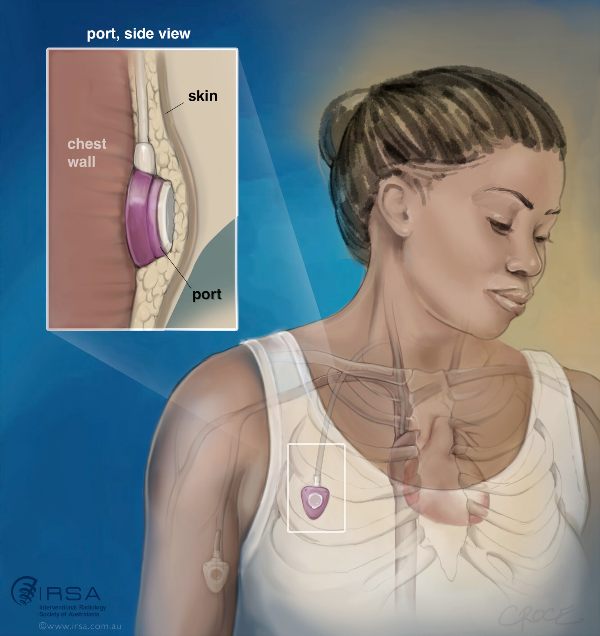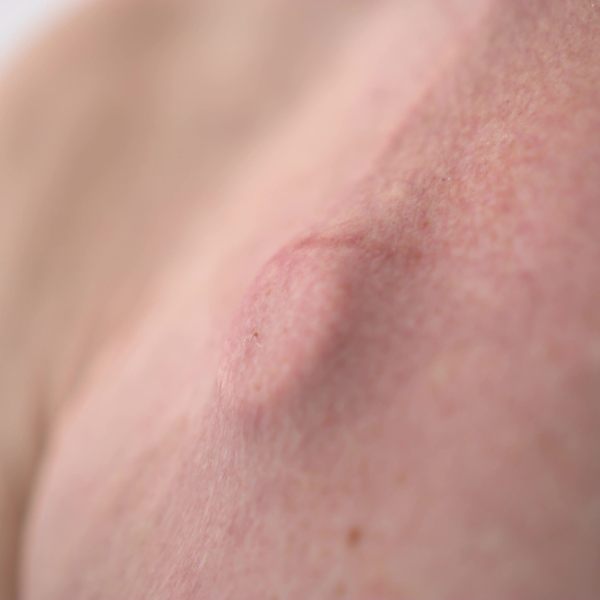PORT INSERTION – MELBOURNE
MEDICATION DELIVERY & BLOOD TEST ACCESS
Learn about Port Insertion including the procedure, benefits, risks and more:
PORT INSERTION – MELBOURNE
Source: Dr Philip Chan – MBBS, MMed (Radiology), FRANZCR, EBIR.
Interventional Radiologist.
WHAT IS A PORT INSERTION
What is a Port Insertion
A Port Insertion is a medical procedure whereby a reservoir compartment (port) is placed under the skin, usually over the chest.
The Port is connected to a long tube (catheter) which enters the vein with the tip located in a large, central vein close to the heart.
A port provides easy, long term access to the vein allowing:
- Delivery of medications
- Delivery of fluids
- Drawing of blood
Source: IRSA – Port Insertion

WHAT HAPPENS DURING A PORT INSERTION
During a Port Insertion – A 3-4 cm incision is made over the chest for the Port (small sealed chamber) and the catheter (plastic tube) is inserted via image guidance. The catheter is guided towards the neck where it will be connected to enter the vein near the heart.
The port sits under the skin and allows easy access for medications and the drawing of blood.
After the procedure the wound is closed with sutures under the skin, which will dissolve over time.
The operation typically takes 30 minutes and can be safely performed under local anaesthesia.
You may also be given intravenous sedation to reduce anxiety and make the local anaesthetic injection less painful.

Source: IRSA – Port Insertion
HOW DO I PREPARE FOR A PORT INSERTION
Preparation – Patients are asked to prepare for an overnight stay in hospital (some patients may be able to go home the same day) and fast for 6 hours before the procedure.
Further testing – You may require more relevant investigations such as blood tests, ultrasound, CT or MRI as part of your work up.
Medications – Your doctor will review your list of medications and you may need to stop these before the operation.
Going home – Have someone drive you home after your procedure.
Your doctor will give you specific instructions based on your unique situation. Hospital information and relative paperwork will be supplied to you by the WIRES Radiology team and admitting hospital staff.
WHAT TO EXPECT AFTER A PORT INSERTION
Immediate post procedure – A needle may be left in place if your doctor is planning for a treatment session soon after your procedure.
You may expect some swelling, redness and pain over the incision site, which will improve over the next 7-14 days.
Follow up – Your doctor will arrange for your Port to be checked over the next 7-14 days. Education related to the Port care is usually provided by the day oncology unit.
Going home – Most patients can expect to go home the same day of the procedure.
ADVANTAGES OF PORT INSERTION
A port insertion procedure offers several advantages, particularly for individuals requiring frequent or long-term intravenous treatments including:
Reduced needle sticks
Minimised vein damage
Easier access for blood draws
Allows for long term access IV access
Increased comfort and convenience for patients
FREQUENTLY ASKED QUESTIONS
A Port Insertion is viewed as a low risk procedure. All medical procedures carry some risks, which may include but not limited to:
- Bruising or bleeding at the procedure site
- Blood vessel injury
- Wound infection
- Mild pain or fever following the procedure
- Chance of allergic reaction to the X-ray dye and drugs used during the procedure
- Air entering the vein which can be serious
Your interventional radiologist will thoroughly explain these risks and answer any questions you have before proceeding.
There’s really no sleep position that’s dangerous for someone with a port.
It’s best to avoid sleeping positions that could place unnecessary pressure on your port (that could lead to increased soreness) — like sleeping with your arms raised above your head or on your stomach, especially during the recovery period after the insertion.
Sleeping on your side may help – If your port is on the right side of your chest, try sleeping on your left side — or vice versa.
The port can be used immediately after it has been put in place and approved by your doctor.
You may feel pressure or a slight pinch when a needle is inserted in your port.
Having a port makes blood draws, infusions and injections much more tolerable compared to a traditional intravenous (IV) line or numerous needle injections.
Showering – Most patients can usually shower 24 to 48 hours after a port insertion. Patients are advised when showering to cover the surgical site with plastic wrap so it doesn’t get wet.
Once you’ve healed from your procedure, you can shower, bathe or even swim with your port.
Please follow the advice of your doctor after your port insertion procedure and ask for clarification if you are unsure about how to care for your port.
Checking the port site – The area where your port is placed must be checked regularly for signs of infection or other potential problems.
Washing hands – Always wash your hands with soap and water before touching the port site or the area around it, as it may help prevent infection.
Port care directions – Ask your doctor for written directions about caring for the port site (which includes cleaning your skin and changing the bandage while your port site heals), and information about hand hygiene.
First week after insertion – In the first week, you should avoid strenuous exercise involving the chest area and avoid fully submerging the port site, though you can shower and pat the dressing dry.
Once the port site has healed – Once fully healed, you can remove the bandage/covering from the site. You can resume all normal activity including exercise and swimming.


